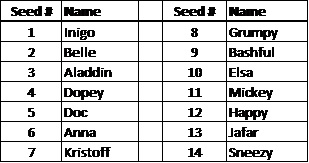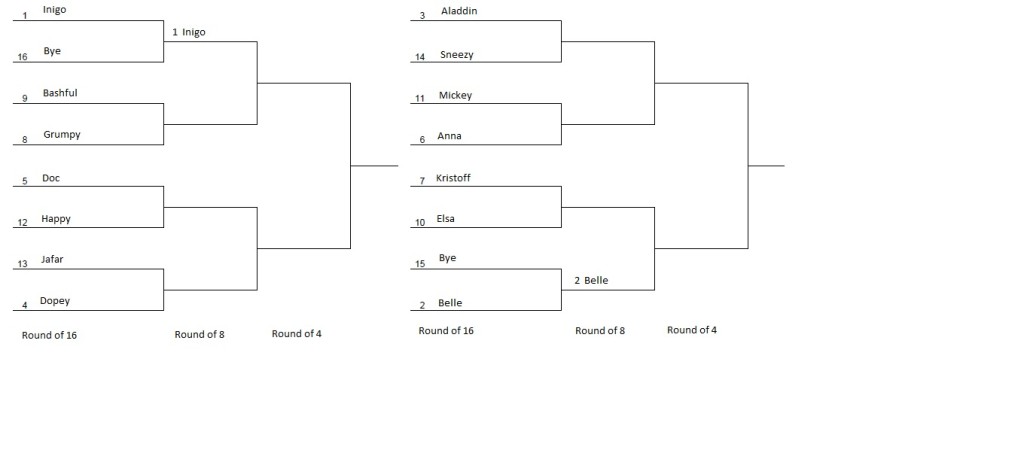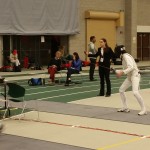Last month, Parent’s Corner discussed how to read pool results and how this leads to a seeding for a direct elimination (DE) round of a fencing tournament. This month we’ll review how the DE round works and, based on pool round results, which fencers compete in each round. We’ll also cover why some fencers get a “bye” in the first round (meaning they don’t have to fence).
For anyone familiar with March Madness brackets in NCAA basketball, the DE round of fencing tournaments is very similar. Depending on the size of the event, the DE round will be a tableau of 8, 16, 32, 64, or 128 (it goes on from there in powers of two for larger events, but those are rare).
The size of the tableau depends on the number of fencers in the event. If there are between 33 and 64 fencers in the event, then the tableau is 64. If there are between 17 and 32 fencers, then a tableau of 32 is used, and so on.
We’ll use a hypothetical tournament of 14 fencers as an example. Here are their results after pools:

To fit all the fencers in the tableau, the DE round will be a tableau of 16. Each fencer is assigned to the tableau based on their seeding in the pool round — from 1 to 14. The way the numbers are assigned for bouts makes sure the #1 seed out of pools fences the #16 seed, #2 fences #15, #3 fences #14, and so on.

There were only 14 fencers in this event, so who do the top 2 seeds Inigo and Belle fence first? The tableau gives them a “bye” as shown above, and the fencing continues exactly as if they had fenced and won their bout. This is what a bye means – they get to skip a round as if they won. This is one advantages of being highly seeded out of pools! The number of fencers that get a bye depends on the number of unfilled spaces in the tableau. If there were 16 fencers, then no fencer would get a bye for the first DE round (the round of 16 in this case). However, if there were only 9 fencers, anyone in the tableau that would have fenced seed numbers 10 through 16 would get a bye.
There is another big advantage to being highly seeded out of pools. The higher a fencer finishes in the pool results, the more DE rounds it will be before they face a fencer that had a better seeding out of pools. Look at Belle, the #2 fencer at the bottom right of the tableau above. She gets a bye in the first round (because there was no #15 fencer). Then in the next round (the “round of 8”), she will fence the winner of a bout between the #7 seed (Kristoff) and #10 seed (Elsa). Assuming Belle wins that bout, the highest possible ranked fencer she will face in her next DE bout (the “round of 4”, or “semi-finals”) is the #3 seeded fencer, Aladdin, if he won all of his prior DE bouts.
In other words, the best two fencers out of pools won’t face each other until the finals. It’s guaranteed that if #1 seed Inigo and #2 seed Belle both win all of their DE bouts up to the finals, they will face each other in the final bout.
Keep this in mind as you gently encourage your fencer – every touch counts in the pools. It’s not only how many bouts you win. In our hypothetical event of 14 fencers, it is possible if there are many fencers of similar ability that four or five of them may come out of the pools with 3 wins. As mentioned in the October 2015 parent’s corner, the tie-breaker for seeding is called the indicator (how many touches they scored minus how many touches they received). Losing 5-4 is better than losing 5-0, and winning 5-0 is better than winning 5-4 for the tie-breaker. Scoring more touches and having fewer scored against can help get a better seeding, which may give a fencer better match-ups for their early DEs.
Remember that a good fencer can have a bad day and be seeded poorly out of pools, but still win the event. A less experienced fencer can fence exceptionally well in pools, but then lose their first DE. Your fencer should never assume they will either win or lose any DE bout!
Next month will be the final installment of understanding tournament results – understanding how a fencer is given a final result position based on their seeding out of pools and the DE round in which they are eliminated.



